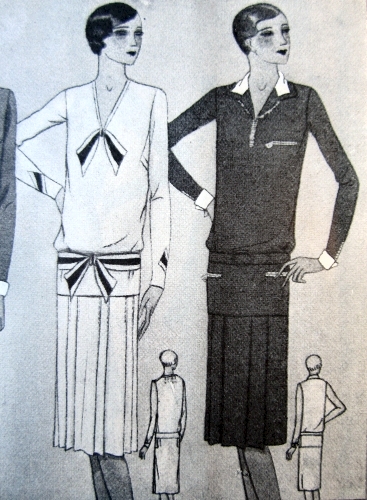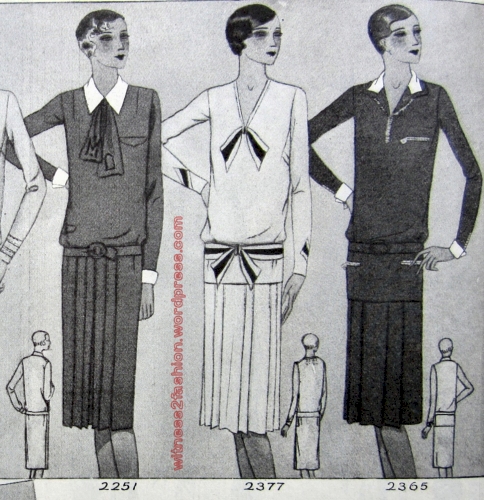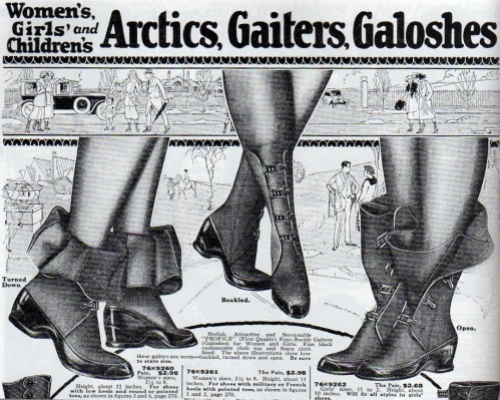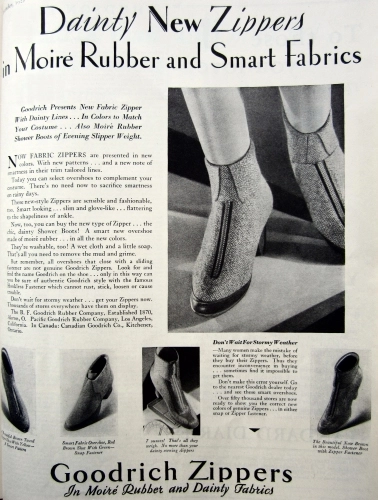There’s something very unusual about the dress on the right.
Talon Zipper Advertisement, March 1929
This full-page advertisement for Talon slide-fasteners, made by the Hookless Fastener Company, appeared in Delineator magazine in March, 1929. (They were not called zippers, yet, because in 1929 a “Zipper” was a trademarked rain boot made by the B. F. Goodrich rubber company.)
Slide fasteners had been used in clothing, money belts, sleeping bags, etc. by the military in World War I, and in some men’s sportswear after the war, but they were not yet associated with women’s clothing. Many references will tell you that Elsa Schiaparelli pioneered the use of zippers in womens’ clothing in the 1930s, but in fact, she was not the first or the only designer who used them. [She does deserve credit for pioneering the use of colored plastic zippers, and for generating the most publicity about zippers being used in women’s wear in the mid-thirties.] 
From 1924 to 1927, the Hookless Fastener Company had been selling seventy per cent of its output to B.F. Goodrich to use in ‘Zippers.’
Then, suddenly, the novelty wore off (or the market was saturated), and Hookless was forced to find other markets, and other uses for its products. Hence, this campaign to introduce slide fasteners to home stitchers.
We take zippers so much for granted now that this ad bears close examination:
How to Find a Zipper
The mid section of the advertisement shows women what the display case — “Talon Cabinet” — at the fabric store will look like:
. . . and what a zipper in a package looks like, too.
The women shopping for zippers are wearing dresses that close with zippers. 
 The fine print in this ad is what sent me pouring through old Delineators: “Frock illustrated can be made with Butterick Pattern No. 2365. Note the Talon Slide-Fasteners used as a smart style feature.”
The fine print in this ad is what sent me pouring through old Delineators: “Frock illustrated can be made with Butterick Pattern No. 2365. Note the Talon Slide-Fasteners used as a smart style feature.”
Here it is, featured in the December 1928 issue of Butterick’s Delineator magazine.
Butterick Pattern No. 2365, a Dress with Zippers, 1928
#2365: “A two-piece frock adds the metal trimming touch of slide fasteners that deftly close the turn back collar, pockets, and cuffs of the slip-over blouse. There is a narrow belt, and the one-piece straight skirt is plaited [i.e., pleated] in front and plain in back. The frock is designed for 32 to 35 (15 to 18 years) and 36 to 48 [bust measurement.]”
Of course, it’s impossible to know if any home stitchers actually made pattern #2365 in 1929. Zippers were relatively expensive — probably why the ad mentions that they will outlast the garments they’re put into — and this pattern uses six of them. The design does reinforce the message that Talon slide fasteners come in “10 lengths and 6 colors of tape.” And, as in many Schiaparelli designs of the 1930s, there is no attempt to conceal the zippers; they are used as trim as much as for convenience.
The same issue of Delineator (March 1929) featured a line-for-line copy of an ensemble by Madeleine Vionnet which also uses zippers. But that deserves an entire post to itself!
Two good sources for information on the history of the device we now know as the zipper are Zipper: An Exploration in Novelty, by Robert Friedel, and The Evolution of Useful Things, by Henry Petroski.
Three Dresses from Butterick, December 1928
The white dress next to the zipper dress is so attractive I feel obliged to give more information about it, and about the one on the far left.
The white dress, # 2377 : “Bow knot trimming of selvage border at the V neck, close sleeves, and belt are extraordinarily smart. A skirt in front has pairs of plaits while the back is one piece, with tucks at the neck. The frock is especially good for borders. It is designed for 32 to 35 (15 to 18 years) and for sizes 36 to 44 [bust measurement.]”
The dress on the left, # 2251: “A tailored frock of light-weight wool or flannel to start the day has the new starched collar and cuffs. It is cut in one piece and trimmed with two smart pockets, tie and belt, and may be made without the inserted plaits in front, if you wish to use a heavier material. Designed for 32 to 35 (15 to 18 years); and for sizes 36 to 44 [bust measurement.]“
















